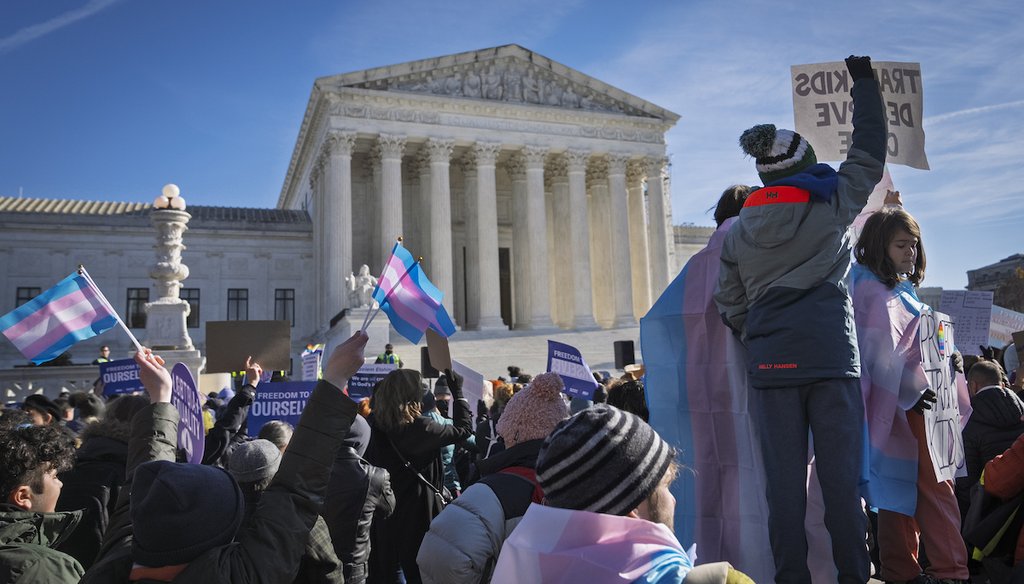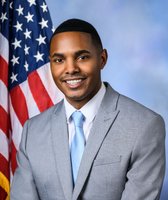Stand up for the facts!
Our only agenda is to publish the truth so you can be an informed participant in democracy.
We need your help.
I would like to contribute

Supporters of transgender rights rally by the Supreme Court, Wednesday, Dec. 4, 2024, in Washington, while arguments are underway in a case regarding a Tennessee law banning gender-affirming medical care for transgender youth. (AP)
If Your Time is short
-
Recent studies of adolescents who have received gender-affirming medical treatment, the subject of Tennessee’s ban, show the rates of people stopping treatment, regretting treatment, or reverting to their birth-assigned sex range from 1% to 9%, with most being on the lower end of that range.
-
The claim that 85% of kids will grow out of their transgender identities derives from a collection of 10 older studies published from 1968 to 2008. With 246 participants, the studies focused on children who had not hit puberty and who are ineligible for medical interventions available today.
-
The diagnostic criteria for gender dysphoria in children have narrowed since a version of the diagnosis was introduced in 1980. Critics argue that many older studies’ participants would not meet today’s criteria to be diagnosed with gender dysphoria.
When the U.S. Supreme Court heard oral arguments in a Tennessee case challenging the constitutionality of the state’s ban on gender-affirming care for transgender youth, one justice homed in on two sparring figures: 1% and 85%
Justice Sonia Sotomayor said both numbers claimed to represent how many children express "regret" after receiving treatment for gender dysphoria, the experience of distress that some people feel when their sex and gender identity don’t align.
But the chasm between the figures was profound.
Amid attorneys’ Dec. 4 oral arguments in U.S. v. Skrmetti, Sotomayor referred to figures provided by Tennessee’s attorney general, Jonathan Skrmetti, for the defense. "Respondents cite a figure of 85% of children expressing gender dysphoria regret later," Sotomayor said.
"You use a figure of 1% of minors who receive this treatment expressing regret," Sotomayor continued, addressing plaintiffs’ lawyers, who cited the figure in their own briefs. "Can you tell me where those figures lie, and exactly what the difference is between that 1% of children who receive these treatments expressing regret, and the 85%."
Sotomayor’s characterization of the numbers wasn’t entirely accurate, but the transgender youth treatment debate centers on the essence of her question: What is the risk that youth will regret receiving gender-affirming medical treatment as they get older?
Sign up for PolitiFact texts
We dug into the opposing numbers and found that although they’re both grounded in research, they are studying two different things. The 85% value is rooted in old studies that focused on younger children who don’t receive gender-affirming medical care.
Recent studies involving adolescents who have received the care, which can include puberty blockers and hormones, report low rates — less than 9% and often much lower— of ceasing treatment, reverting to identify as their sex assigned at birth or expressing regret.
‘85%’ statistic based on older studies of children, not teens who get treatment today
The 85% cited in Tennessee’s legal briefs have been used to justify gender-affirming regulations across the country.
Tennessee's ban, known as S.B. 1, passed in March 2023 and bars doctors from performing medical procedures "for the purpose of enabling a minor to identify with, or live as, a purported identity inconsistent with the minor’s sex" assigned at birth. That includes puberty blockers and hormones given as part of gender-affirming care. Plaintiffs argue the ban is discriminatory because those same treatments are still available to treat other conditions, such as congenital defects.
In their argument supporting the ban, defense attorneys wrote, "If left untreated by transition methods, gender dysphoria goes away on its own for the ‘large majority’ (about 85%) of children.
The figure traces to a 2011 Dutch research paper that reviewed the results of 10 studies published from 1968 to 2008 and said: "Feelings of gender dysphoria persisted into adolescence in only 39 out of 246 children (15.8%) who were investigated in a number of prospective follow-up studies."
In 2013, the researchers’ follow-up studies cited this finding and that figure’s inverse to say that 84% to 85% of the children "desisted," as they grew older or stopped expressing behaviors or feelings that seemed at odds with their sex assigned at birth.
But this value and the studies underlying it merit context.
First, none of the studies represented in the 85% figure examined adolescents who medically transitioned and then "detransitioned" or said they regretted their treatment.
Each of the studies in the original paper analyzed whether children who displayed gender-nonconforming behavior or identity in childhood continued to identify that way in adolescence or stopped feeling that way as they aged. People who continued to identify as a gender other than the one they were assigned at birth were said to be "persisting" while the others who seemed to have a change of perspective were said to be "desisting."
The studies behind this figure focused on children who haven’t reached puberty and most predated access to medical care for trans youth, which started in Europe in the late 1990s. Per today’s medical guidelines, children this young are not prescribed medical treatments such as puberty blockers or hormones.
Second, 8 out of 10 of the studies reviewed were published before 2000; six came in the 1970s and 1980s.
A 1987 study included in the research was titled, "The ‘sissy boy syndrome’ and the development of homosexuality." A 1978 study was called, "Effeminate behavior present in boys from childhood."
In some cases, the research subjects were identified based on gender stereotypes. The 1987 study, for instance, advertised that it was seeking families with "feminine boys." In the end, just 30% of the children examined had "frequently" stated a desire to be a girl, and 15% more had never stated such a desire.
Another study from 1979 required the children in the study show "exceptional interest in dressing in girls' clothing; avoiding play activities typical of boys and preferring those of girls; walking and talking more like girls than boys; and stating overtly the wish to be a girl."
"Under those circumstances, you have young people coming in who were never transgender in the first place," said Kellan Baker, executive director of Whitman Walker Institute, a nonprofit focused on LGBTQ+ health research and policy. "They were brought in because they were expressing some form of gender nonconformity. Maybe they were tomboys. Maybe they were a little too feminine for boys. Maybe they were gay."
Diagnostic standards previously used to identify children who may have been transgender have changed since 1968. Three studies included in the 2011 Dutch review predated 1980, which was when the Diagnostic and Statistical Manual of Mental Disorders first introduced a diagnosis of "gender identity disorder of childhood."
The DSM-IV criteria from 1994 to 2013, for example, required the child to exhibit a "persistent discomfort" with their sex or "gender role." The child could also express a desire to be a different sex, but the DSM-IV did not outline that desire as necessary for receiving the diagnosis.
Many early studies did not require a diagnosis to be included. Twenty-five percent to 40% of the participants in two 2008 studies that make up part of the 85% statistic did not meet the diagnosis threshold under the then-DSM standard.
Today, a childhood gender dysphoria diagnosis requires "a strong desire to be of the other gender or an insistence that one is the other gender."
Dr. Jack Drescher, a Columbia University professor and psychiatrist who helped revise that section in the DSM-5 released in 2013, told PolitiFact the current gender dysphoria in children diagnosis reflects an "attempt to narrow diagnostic criteria."
Not all transgender people experience gender dysphoria, and someone needn’t be diagnosed to identify as transgender. But critics say these varying standards and shifting attitudes toward gender-nonconforming behavior mean earlier studies may have included children who would not be considered transgender today.
The Dutch researchers wrote in 2016, "The lower persistence rates in the earlier studies, compared to the more recent studies after 2000, may be the result of the inclusion of less extreme cases in the earlier studies."
Baker also said the studies included in the 85% figure span five decades of shifting American attitudes towards transgender identity, including a period when mental health professionals often used conversion therapy to dissuade people from continuing to identify as transgender.
Research from 2022, meanwhile, followed 317 kids who socially transitioned and found that an average of five years later, 94% still identified as transgender and 3.5% identified as nonbinary.
Is it as low as 1%?
Sotomayor’s 1% number referred to studies the plaintiffs' lawyers cited in briefs.
"The rate of regret among those who have actually received medical treatment for gender dysphoria is exceedingly low… noting studies documenting rates of regret below 1%," they wrote.
The studies they cited, however, didn’t involve only minors. One study was a 2018 Dutch review of 6,793 people (including 1,360 who were minors at their first visit) who visited the Amsterdam Gender clinic from 1972 to 2015. Among all patients who, as adults, had testes or ovaries surgically removed, the rate of regret was 0.5%. All 14 people who expressed regret started treatment as adults.
The other cited study was a 2021 case note review of 175 adult patients at a United Kingdom gender clinic. In the review, 12 patients (6.9%) "were agreed by all authors to meet the case definition for detransitioning." But "regret was specifically documented in two cases," or 1.1%
Recent studies that followed young people who accessed gender-affirming medical care as adolescents have found similarly low percentages of people stopping their care, expressing "regret" or returning to the gender identities assigned at birth.
PolitiFact identified 10 studies that examined variations of this question and found that the research typically showed 1% to 9% of adolescents stopping care. Here are six such studies:
-
A 2024 American study surveyed 220 youth who accessed puberty blockers or hormones. Of the 220, nine (4%) expressed regret about one of the treatments. Of those nine, five stopped gender-affirming medical care or planned to stop. The other four continued care.
-
A 2023 study out of the Netherlands reviewed the cases of 1,766 children and adolescents who visited an Amsterdam gender identity clinic for treatment from 1997 to 2018. Researchers found that of the 882 adolescents who started taking puberty blockers, 1.4% stopped, most often because their gender dysphoria lessened. Ninety-three percent of those who took blockers continued on to take gender-affirming hormones.
-
A 2022 study out of England reviewed the discharge records of 1,089 transgender youth who were ages 7 to 22 at the time they were referred to a U.K. gender clinic. Nearly 3% stopped identifying as transgender before any endocrine intervention and 5.3% stopped treatment during puberty blockers or hormones — most stopped during puberty blockers. Nearly 92% continued identifying as transgender or gender variant, and 86.8% were discharged to adult gender identity clinics for continued care.
-
A 2022 study out of the Netherlands concerned 720 youth ages 13 to 17 from the Amsterdam Cohort of Gender Dysphoria, who received puberty blockers and hormones as minors. Using a nationwide prescription registry, researchers reviewed whether participants ages 17 to 24 at follow-up had continued taking gender-affirming hormones as adults. Ninety-eight percent of participants who started treatment as adolescents continued on follow-up.
-
A 2022 study in Spain reviewed the medical records of all underage applicants to the Gender Identity Unit in Catalonia, Spain from 1999 to 2016. Out of 124, 97.6% of transgender minors persisted in their identities, with a median follow-up time of 2.6 years. Three individuals were "desisters," one of whom never initiated hormonal treatment.
-
A 2021 study in the U.K. examined medical records of 91 young people ages 8 to 17 who had been diagnosed with gender dysphoria and referred to a Scottish endocrinology clinic from 2011 to 2019. Of 79 young people who started puberty blockers, six stopped treatment six to 18 months later. That’s 8%. Three of them stopped because their gender dysphoria had faded; the other three were not following treatment protocol. Out of 41 who later started hormones, one participant (2%) discontinued hormone treatment.
Numbers of detransition or regret are often even lower for adults, research shows.
The reasons people "detransition" or stop gender-affirming medical care are increasingly diverse, and don’t always mean someone’s identity has reverted to their birth-assigned sex, said Dr. Jey Blodgett, an expert in transgender issues and a member of Oregon State University's leadership team for the Oregon Parenting Education Collaborative.
Some people may transition to a nonbinary identity, meaning they identify as neither a man nor a woman, or stop medical intervention after they have achieved a certain appearance.
"Ceasing to take puberty blockers, (hormone replacement therapy), or other medical interventions should not be interpreted as someone ‘detransitioning,’" Blodgett said. And being transgender does not mean a person must pursue medical interventions.
Other people may change their gender presentation or pronouns, without regret. Detransitioners may see their transition as an important part of their gender exploration, or detransition because of social, familial, or economic pressures, experts said.
A 2024 study based on a survey of almost 4,000 LGBTQ+ young people ages 15 to 29 found that of the 720 people who started gender-affirming medical treatment, 16.8% reported ever stopping treatment. About 37% of the people in that group said they wished they hadn’t stopped, and 80.2% who stopped still identified themselves as transgender or having another "gender-diverse identity."
Our Sources
Interview with Kellan Baker, executive director of Whitman Walker Institute, Dec. 10, 2024
Email interview with Dr. Jack Dresher, Clinical Professor of Psychiatry at Columbia University, Dec. 10, 2024
Interview with Dr. Jack Turban, pediatric psychiatrist, Dec. 11, 2024
Email interview with Jey Blodgett, Postdoctoral Scholar at Oregon State University, Dec. 11, 2024
Email interview with Gillian Branstetter, Communications Strategist at the ACLU, Dec. 9, 2024
Statement for the Endocrine Society, Dec. 12, 2024
U.S. Supreme Court, "Brief for the Petitioner No. 23-477," Aug. 27, 2024
U.S. Supreme Court, "Joint Appendix Volume 1 No. 23-477," Aug. 27, 2024
U.S. Supreme Court, "Joint Appendix Volume 2 No. 23-477," Aug. 27, 2024
U.S. Supreme Court, "Brief for the Respondents in support of Petitioner No. 23-477," Aug 27, 2024
U.S. Supreme Court, "Brief for Respondents No. 23-477," Oct. 8, 2024
U.S. Supreme Court, "Reply Brief for the Respondents No. 23-477," Nov. 27, 2024
Legiscan, "TN SB1 | 2023-2024," March 22, 2023
Journal of the American Academy of Child & Adolescent Psychiatry, "Factors Associated With Desistence and Persistence of Childhood Gender Dysphoria: A Quantitative Follow-Up Study," June 2013
Journal of the American Academy of Child & Adolescent Psychiatry, "Psychosexual Outcome of Gender-Dysphoric Children," 2008
Developmental Psychology, "A follow-up study of girls with gender identity disorder," 2008
JAMA Pediatrics, "Levels of Satisfaction and Regret With Gender-Affirming Medical Care in Adolescence," Oct. 21, 2024
Counseling Psychology Review, "Detransition rates in a large national gender identity clinic in the UK ," June 2019
Journal of Sexual Medicine, "The Amsterdam Cohort of Gender Dysphoria Study (1972-2015): Trends in Prevalence, Treatment, and Regrets," 2018
BJPsych Open, "Access to care and frequency of detransition among a cohort discharged by a UK national adult gender identity clinic: retrospective case-note review," 2021
Archives of Sexual Behavior, "An Analysis of All Applications for Sex Reassignment Surgery in Sweden, 1960-2010: Prevalence, Incidence, and Regrets," May 2014
Journal of Adolescent Health, "Discontinuation of Gender-Affirming Medical Treatments: Prevalence and Associated Features in a Nonprobabilistic Sample of Transgender and Gender-Diverse Adolescents and Young Adults in Canada and the United States," Oct. 2024
PolitiFact, "Transgender youth health care: A fact-checker’s look at Supreme Court oral arguments in Tenn. case," Dec. 6, 2024
PolitiFact, "‘Gender dysphoria’: What it is, what it isn’t and how history has changed its view," May 22, 2024
PolitiFact, "Florida leaders misrepresented research before ban on gender-affirming care," Dec. 2, 2024
Clinical child Psychology and Psychiatry, "Desisting and persisting gender dysphoria after childhood: A qualitative follow-up study," Oct. 2011
Internet Archive, "The "sissy boy syndrome" and the development of homosexuality," 1987
Comprehensive Psychiatry, "Effeminate behavior present in boys from childhood: Ten additional years of follow-up," 1978
Los Angeles Blade, "No, 80% Of Trans Youth Do Not Detransition," March 17, 2023
Psychiatry Online, "DSM-IV-TR Diagnostic Criteria For Gender Identity Disorder," July 2023
American Psychiatric Association, "What is Gender Dysphoria?," Aug. 2022
International Journal of Transgenderism, "A critical commentary on follow-up studies and "desistance" theories about transgender and gender non-conforming children," 2018
International Review of Psychiatry, "Gender dysphoria in childhood," 2016
Journal of Pediatric Psychology, "Homosexual Outcome of Discordant Gender Identity /Role in Childhood: Longitudinal Follow-Up'," 1979
American Academy of Pediatrics, "Gender Identity 5 Years After Social Transition," July 13, 2022
Children, "Developmental Pathway Choices of Young People Presenting to a Gender Service with Gender Distress: A Prospective Follow-Up Study," 2023
The Journal of Sexual Medicine, "Children and adolescents in the Amsterdam Cohort of Gender Dysphoria: trends in diagnostic- and treatment trajectories during the first 20 years of the Dutch Protocol," January 2023
Archives of Disease in Childhood, "Discharge outcome analysis of 1089 transgender young people referred to paediatric endocrine clinics in England 2008-2021," Oct. 2022
The Lancet, "Continuation of gender-affirming hormones in transgender people starting puberty suppression in adolescence: a cohort study in the Netherlands," Dec 2022
European Journal of Pediatrics, "An appraisal of current service delivery and future models of care for young people with gender dysphoria," 2021
Archives of Sexual Behavior, "Trajectories of Adolescents Treated with Gonadotropin-Releasing Hormone Analogues for Gender Dysphoria," 2020
Journal of Pediatrics, "Clinical management of youth with gender dysphoria in Vancouver," 2014
PLoS One, "Short-term outcomes of pubertal suppression in a selected cohort of 12 to 15 year old young people with persistent gender dysphoria in the UK," 2021
Spanish Journal of Psychiatry and Mental Health, "High persistence in Spanish transgender minors: 18 years of experience of the Gender Identity Unit of Catalonia," 2022
Journal of Adolescent Health, "Discontinuation of Gender-Affirming Medical Treatments," October 2024
Slate, "What alarmist articles about transgender children get wrong," Jan. 14, 2016
KQED, "The Controversial Research on 'Desistance' in Transgender Youth," May 23, 2018
International Journal of Transgenderism, "Full article: A critical commentary on "A critical commentary on follow-up studies and "desistence" theories about transgender and gender non-conforming children"," May 2018
Medium, "How Common is Detransition? A Review of all the Evidence | by Lexi Henny," March 24, 2023
Erin in the Morning, "Debunked: No, 80% Of Trans Youth Do Not Detransition," March 17, 2023
Hormones and Behavior, "Gender identity development in adolescence," July 2013






































